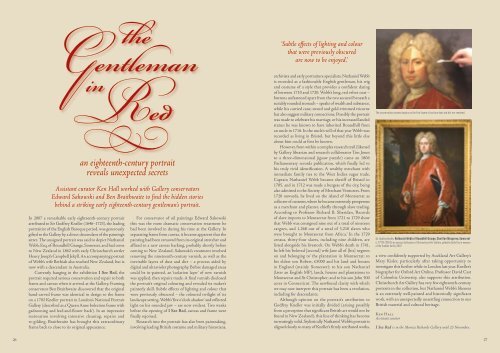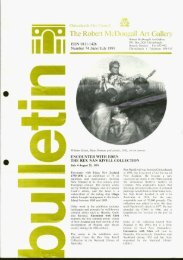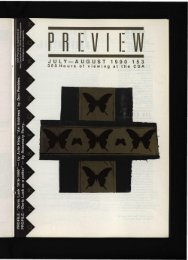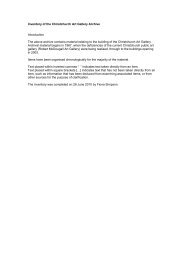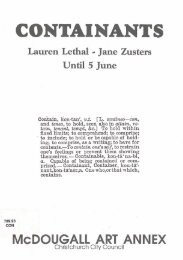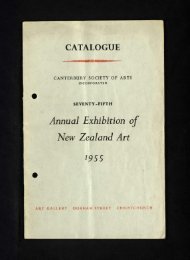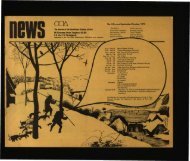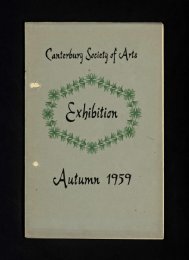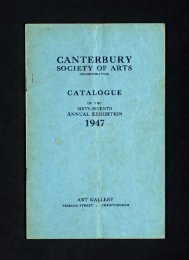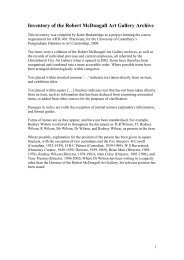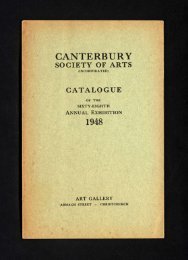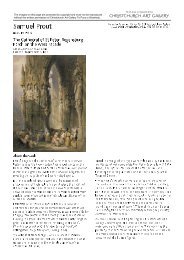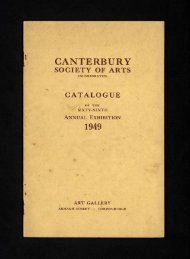Download (2.2 MB) - Christchurch Art Gallery
Download (2.2 MB) - Christchurch Art Gallery
Download (2.2 MB) - Christchurch Art Gallery
You also want an ePaper? Increase the reach of your titles
YUMPU automatically turns print PDFs into web optimized ePapers that Google loves.
In 2007 a remarkable early eighteenth-century portrait<br />
attributed to Sir Godfrey Kneller (1646–1723), the leading<br />
portraitist of the English Baroque period, was generously<br />
gifted to the <strong>Gallery</strong> by a direct descendant of the painting’s<br />
sitter. The unsigned portrait was said to depict Nathaniel<br />
Webb, Esq. of Roundhill Grange, Somerset, and had come<br />
to New Zealand in 1862 with early <strong>Christchurch</strong> settler<br />
Henry Joseph Campbell Jekyll. An accompanying portrait<br />
of Webb’s wife Bethiah also reached New Zealand, but is<br />
now with a descendant in Australia.<br />
Currently hanging in the exhibition I See Red, the<br />
portrait required serious conservation and repair to both<br />
frame and canvas when it arrived at the <strong>Gallery</strong>. Framing<br />
conservator Ben Braithwaite discovered that the original<br />
hand-carved frame was identical in design to the frame<br />
on a 1702 Kneller portrait in London’s National Portrait<br />
<strong>Gallery</strong> (described as a ‘Queen Anne bolection frame with<br />
gadrooning and leaf-and-flower back’). In an impressive<br />
restoration involving intensive cleaning, repairs and<br />
re-gilding, Braithwaite has brought this extraordinary<br />
frame back to close to its original appearance.<br />
an eighteenth-century portrait<br />
reveals unexpected secrets<br />
Assistant curator Ken Hall worked with <strong>Gallery</strong> conservators<br />
Edward Sakowski and Ben Braithwaite to find the hidden stories<br />
behind a striking early eighteenth-century gentleman’s portrait.<br />
For conservator of oil paintings Edward Sakowski<br />
this was the most dramatic conservation treatment he<br />
had been involved in during his time at the <strong>Gallery</strong>. In<br />
separating frame from canvas, it became apparent that the<br />
painting had been removed from its original stretcher and<br />
affixed to a new canvas backing, probably shortly before<br />
coming to New Zealand. Sakowski’s treatment involved<br />
removing the nineteenth-century varnish, as well as the<br />
inevitable layers of dust and dirt – a process aided by<br />
digital and ultraviolet photography. Before damaged areas<br />
could be in-painted, an ‘isolation layer’ of new varnish<br />
was applied, then repairs made. A final varnish disclosed<br />
the portrait’s original colouring and revealed its maker’s<br />
painterly skill. Subtle effects of lighting and colour that<br />
were previously obscured – the coloured twilight of its<br />
landscape setting, Webb’s ‘five o’clock shadow’ and reflected<br />
light on his rounded jaw – are now evident. Two weeks<br />
before the opening of I See Red, canvas and frame were<br />
finally rejoined.<br />
Research into the portrait has also been painstaking,<br />
involving leading British costume and military historians,<br />
‘Subtle effects of lighting and colour<br />
that were previously obscured<br />
are now to be enjoyed.’<br />
archivists and early portraiture specialists. Nathaniel Webb<br />
is recorded as a fashionable English gentleman, his wig<br />
and costume of a style that provides a confident dating<br />
of between 1710 and 1720. Webb’s long, red velvet coat –<br />
buttons unfastened apart from the two secured beneath a<br />
suitably rounded stomach – speaks of wealth and substance,<br />
while his carried cane, sword and gold-trimmed tricorne<br />
hat also suggest military connections. Possibly the portrait<br />
was made to celebrate his marriage, or his increased landed<br />
status: he was known to have inherited Roundhill from<br />
an uncle in 1716. In the uncle’s will of that year Webb was<br />
recorded as living in Bristol, but beyond this little else<br />
about him could at first be known.<br />
However, from within a complex research trail (likened<br />
by <strong>Gallery</strong> librarian and research collaborator Tim Jones<br />
to a three-dimensional jigsaw puzzle) came an 1806<br />
Parliamentary records publication, which finally led to<br />
his truly vivid identification. A wealthy merchant with<br />
immediate family ties to the West Indies sugar trade,<br />
Captain Nathaniel Webb became sheriff of Bristol in<br />
1705, and in 1712 was made a burgess of the city, being<br />
also admitted to the Society of Merchant Venturers. From<br />
1720 onwards, he lived on the island of Montserrat as<br />
collector of customs, where he became extremely prosperous<br />
as a merchant and planter, chiefly through slave trading.<br />
According to Professor Richard B. Sheridan, ‘Records<br />
of slave imports to Montserrat from 1721 to 1729 show<br />
that Webb was consigned nine out of a total of nineteen<br />
cargoes, and 1,268 out of a total of 3,210 slaves who<br />
were brought to Montserrat from Africa.’ In the 1729<br />
census, thirty-four slaves, including nine children, are<br />
listed alongside his livestock. On Webb’s death in 1741,<br />
he left his ‘beloved [second] wife Jane all of [his] negroes<br />
on and belonging to’ the plantation in Montserrat; to<br />
his eldest son Robert, £5000 and his land and houses<br />
in England (mainly Somerset); to his son Nathaniel<br />
(later an English MP), lands, houses and plantations in<br />
Montserrat and St Christopher; and to his son John 500<br />
acres in Connecticut. The newfound clarity with which<br />
we may now interpret this portrait has been a revelation,<br />
including for descendants.<br />
Although opinion on the portrait’s attribution to<br />
Godfrey Kneller was initially divided (arising possibly<br />
from a perception that significant British art would not be<br />
found in New Zealand), this line of thinking has become<br />
increasingly solid. Stylistically Nathaniel Webb’s portrait is<br />
aligned closely to many of Kneller’s firmly attributed works,<br />
The conservation process begins as the first layers of surface dust and dirt are removed.<br />
Sir Godfrey Kneller Nathaniel Webb of Roundhill Grange, Charlton Musgrove, Somerset<br />
c.1710–20. Oil on canvas. Collection of <strong>Christchurch</strong> <strong>Art</strong> <strong>Gallery</strong>, gifted by Sally Fox in memory<br />
of the Cuddon family, 2007<br />
a view confidently supported by Auckland <strong>Art</strong> <strong>Gallery</strong>’s<br />
Mary Kisler, particularly after taking opportunity to<br />
investigate this further while in London last year. Kneller’s<br />
biographer for Oxford <strong>Art</strong> Online, Professor David Cast<br />
of Colombia University, also supports this attribution.<br />
<strong>Christchurch</strong> <strong>Art</strong> <strong>Gallery</strong> has very few eighteenth-century<br />
portraits in the collection, but Nathaniel Webb’s likeness<br />
is an extremely well-painted and historically significant<br />
work, with an unexpectedly unsettling connection to our<br />
British material and cultural heritage.<br />
Ken Hall<br />
Assistant curator<br />
I See Red is in the Monica Richards <strong>Gallery</strong> until 23 November.<br />
26 27


